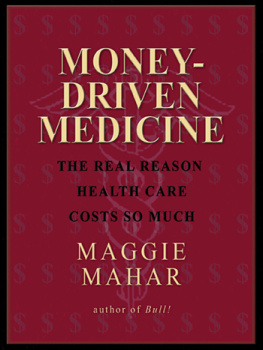Glen de Vries - The Patient Equation: The Data-Driven Future of Precision Medicine and the Business of Health Care
Here you can read online Glen de Vries - The Patient Equation: The Data-Driven Future of Precision Medicine and the Business of Health Care full text of the book (entire story) in english for free. Download pdf and epub, get meaning, cover and reviews about this ebook. year: 2020, genre: Business. Description of the work, (preface) as well as reviews are available. Best literature library LitArk.com created for fans of good reading and offers a wide selection of genres:
Romance novel
Science fiction
Adventure
Detective
Science
History
Home and family
Prose
Art
Politics
Computer
Non-fiction
Religion
Business
Children
Humor
Choose a favorite category and find really read worthwhile books. Enjoy immersion in the world of imagination, feel the emotions of the characters or learn something new for yourself, make an fascinating discovery.

- Book:The Patient Equation: The Data-Driven Future of Precision Medicine and the Business of Health Care
- Author:
- Genre:
- Year:2020
- Rating:5 / 5
- Favourites:Add to favourites
- Your mark:
- 100
- 1
- 2
- 3
- 4
- 5
The Patient Equation: The Data-Driven Future of Precision Medicine and the Business of Health Care: summary, description and annotation
We offer to read an annotation, description, summary or preface (depends on what the author of the book "The Patient Equation: The Data-Driven Future of Precision Medicine and the Business of Health Care" wrote himself). If you haven't found the necessary information about the book — write in the comments, we will try to find it.
Glen de Vries: author's other books
Who wrote The Patient Equation: The Data-Driven Future of Precision Medicine and the Business of Health Care? Find out the surname, the name of the author of the book and a list of all author's works by series.
The Patient Equation: The Data-Driven Future of Precision Medicine and the Business of Health Care — read online for free the complete book (whole text) full work
Below is the text of the book, divided by pages. System saving the place of the last page read, allows you to conveniently read the book "The Patient Equation: The Data-Driven Future of Precision Medicine and the Business of Health Care" online for free, without having to search again every time where you left off. Put a bookmark, and you can go to the page where you finished reading at any time.
Font size:
Interval:
Bookmark:

- Chapter 1
- Chapter 2
- Chapter 9
- Chapter 10
- Chapter 11
- Chapter 12
- Chapter 14
GLEN DE VRIES
WITH JEREMY BLACHMAN

Copyright 2020 by Glen de Vries. All rights reserved.
Published by John Wiley & Sons, Inc., Hoboken, New Jersey.
Published simultaneously in Canada.
No part of this publication may be reproduced, stored in a retrieval system, or transmitted in any form or by any means, electronic, mechanical, photocopying, recording, scanning, or otherwise, except as permitted under Section 107 or 108 of the 1976 United States Copyright Act, without either the prior written permission of the Publisher, or authorization through payment of the appropriate percopy fee to the Copyright Clearance Center, Inc., 222 Rosewood Drive, Danvers, MA 01923, (978) 7508400, fax (978) 6468600, or on the Web at www.copyright.com. Requests to the Publisher for permission should be addressed to the Permissions Department, John Wiley & Sons, Inc., 111 River Street, Hoboken, NJ 07030, (201) 7486011, fax (201) 7486008, or online at http://www.wiley.com/go/permissions.
Limit of Liability/Disclaimer of Warranty: While the publisher and author have used their best efforts in preparing this book, they make no representations or warranties with respect to the accuracy or completeness of the contents of this book and specifically disclaim any implied warranties of merchantability or fitness for a particular purpose. No warranty may be created or extended by sales representatives or written sales materials. The advice and strategies contained herein may not be suitable for your situation. You should consult with a professional where appropriate. Neither the publisher nor author shall be liable for any loss of profit or any other commercial damages, including but not limited to special, incidental, consequential, or other damages.
For general information on our other products and services or for technical support, please contact our Customer Care Department within the United States at (800) 7622974, outside the United States at (317) 5723993 or fax (317) 5724002.
Wiley publishes in a variety of print and electronic formats and by printondemand. Some material included with standard print versions of this book may not be included in ebooks or in printondemand. If this book refers to media such as a CD or DVD that is not included in the version you purchased, you may download this material at http://booksupport.wiley.com. For more information about Wiley products, visit www.wiley.com.
Library of Congress Cataloging-in-Publication Data
Names: De Vries, Glen, 1972 author. | Blachman, Jeremy, author.
Title: The patient equation : the datadriven future of precision medicine and the business of health care / Glen de Vries with Jeremy Blachman.
Description: Hoboken, New Jersey : Wiley, [2020] | Includes bibliographical references and index.
Identifiers: LCCN 2020000657 (print) | LCCN 2020000658 (ebook) | ISBN 9781119622147 (hardback) | ISBN 9781119622178 (adobe pdf) | ISBN 9781119622277 (epub)
Subjects: MESH: Precision Medicine | Data Collection | Biomedical Technology | Monitoring, Ambulatory | Data Science
Classification: LCC R856 (print) | LCC R856 (ebook) | NLM WB 102.7 | DDC 610.28dc23
LC record available at https://lccn.loc.gov/2020000657
LC ebook record available at https://lccn.loc.gov/2020000658
Cover Design: Wiley
Cover Image: teekid/Getty Images
About a decade ago, I met Jack Whelan. An investment researcher working in the world of finance, Jack powerwalked from the train to his office every day for yearsuntil he noticed that walk getting more and more difficult, along with occasional nosebleeds that prompted him to see his doctor. He was diagnosed with a rare blood cancerWaldenstrom macroglobulinemia (WM)and his world changed completely. WM was (and is) incurable, with no FDAapproved treatments and an expected survival of just five to seven years. Wanting to extend his life, Jack sought out clinical trial after clinical trial. The first three trials failed, and then his fourth finally got him on a drug that stopped the cancer's progression for years.
Throughout his experience, Jack became an expertand, more important for our story here, a tracker. Jack demanded weekly blood tests and charted a range of biomarkershematocrit, immunoglobulin, and othershoping to find answers in the numbers, to be able to know if he was responding to treatment even before the doctors did. From physician to physician, from trial to trial, he brought these numbers with him in Excel spreadsheets. He hoped this growing collection of data about his body would uncover new and valuable information that could keep him alive.
Jack's diligence and initiative is rare, but he's not alone. Ray Finucane, a 75yearold mechanical engineer with Parkinson's disease, built an app to track his symptoms and to try to optimize the dosing of his levodopa medication. Dr. David Fajgenbaum used his own blood samples and software to find a new plausible biological explanation for Castleman disease that led him to try a drug never before applied to the conditionwhich has led him into remission for the past six years. Millions of people around the worldsick or notwear fitness trackers or carry smartphones that are able to track massive amounts of data at a far more granular level than we could have ever conceived of just a few years ago.
Imagine a world where this data was harvested, analyzed, and combined with all of the medical records that are collected over the course of our lives and assembled into something useful, something to extend longevity and enhance the quality of life.
Imagine if a patient like Jack didn't need to track his own body in an Excel spreadsheet because there were systems and devices that were doing it for him. What if he could do this while harnessing the collective wisdom of all of the research and realworld experience of the scientists, physicians, and patients who came before him to produce recommendations for the most effective treatments, the most critical behaviors, and the most valuable things he needed to know to beat his cancer and optimize his health?
Imagine a world where as soon as something useful could be detected, be it a data point we can track with conventional medical measurements or a misbehaving molecule or behavioral pattern that we may not even fully appreciate today (something about our sleep, our cognition, what we eat or drink, or an aspect of our environment, as just a few examples), we would be prompted to take action, use a medical device or drug, or change some aspect of how we live.
Instead of being limited to waiting for a scan to show an increased tumor volume or a blood value concentration rising to a level detectable by a relatively crude chemical medical test, imagine realtime, populationtested, scientificallyvalid, differencemaking, actionable recommendationswhether you're fighting cancer or just trying to maintain a healthy, highquality life.
This is the future, and the analysis behind the scenes that will produceand is already producingthese types of information are the patient equations that inspired the title of this book. Jack was ahead of his time because he knew that the numbers and his careful tracking of them mattered. His engineering intuition told him that within those numbers were the mathematical keys to unlocking extended life, and making sure he got the right treatments at the right time.
Next pageFont size:
Interval:
Bookmark:
Similar books «The Patient Equation: The Data-Driven Future of Precision Medicine and the Business of Health Care»
Look at similar books to The Patient Equation: The Data-Driven Future of Precision Medicine and the Business of Health Care. We have selected literature similar in name and meaning in the hope of providing readers with more options to find new, interesting, not yet read works.
Discussion, reviews of the book The Patient Equation: The Data-Driven Future of Precision Medicine and the Business of Health Care and just readers' own opinions. Leave your comments, write what you think about the work, its meaning or the main characters. Specify what exactly you liked and what you didn't like, and why you think so.









